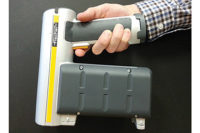X-Ray Fluorescence (XRF) Frequently Asked Questions
You can point an XRF analyzer at almost anything and get a result.

Built for use in rugged environments, the handheld XRF analyzer is IP rated for protection from dust and water, and drop tested.
When we talk to customers who are interested in learning more about XRF, there are some questions that we answer all the time. Check out some of the most frequently asked questions and their answers below.
What is XRF?
XRF stands for X-ray fluorescence. It’s a powerful, nondestructive technique for measuring elemental composition.
How does XRF Work?
An analyzer emits X-rays. The X-rays hit the sample and cause the elements in the sample to fluoresce and travel back to an X-ray detector in the analyzer. The analyzer then counts them and does a lot of complicated math to give you a result.
What can you measure with XRF?
You can point an XRF analyzer at almost anything and get a result. Common applications are as a metal scrap sorter, for alloy grade identification, quality control in metal manufacturing, geological exploration or mining, testing industrial materials like cement or coal, and testing for lead in paint or other contaminants in consumer products.

The handheld XRF results screen for stainless steel 316.
What can’t you measure with XRF?
The elements that are the lightest on the periodic table (below magnesium—for example, hydrogen, carbon, nitrogen, oxygen, and sodium) have X-rays that are too weak to travel back to the detector and get counted. And XRF just tells you how much of what elements are present—it says nothing about the chemical structure.
Why do people use portable, handheld XRF?
Being able to take a lab technique into the field enables the analysis of samples that are too large, unwieldy, or costly to transport to the lab. On-site analysis enables real-time information and decision-making since labs often have a backlog of samples to test. Often, this speed and availability advantage outweighs the power limitations that come with a portable device.

Is XRF dangerous to use because of radiation?
No, handheld XRF is not dangerous when operated as directed. XRF instruments create X-rays that are ionizing radiation, so you should always minimize your exposure. The basic rule is—like anything pistol-shaped—do not point the gun at anyone and pull the trigger. Handheld XRF power is much lower than imaging X-ray equipment, so XRF users’ exposure is the same as or less than you get from naturally occurring sources.
Is XRF complicated?
Not for the user. Once you settle on the right model and the proper calibration for your samples, it’s just “point and shoot” with complete, clear results on the screen.

How long does an XRF test take?
Typical test times range from a second or two for many alloys to up to a minute or two for geological samples. A basic rule of thumb is that lower concentrations take longer. If you’re just interested in bulk composition, then testing takes seconds. If you’re interested in trace concentration (down to single digit parts per million), then longer tests are required.
Looking for a reprint of this article?
From high-res PDFs to custom plaques, order your copy today!





